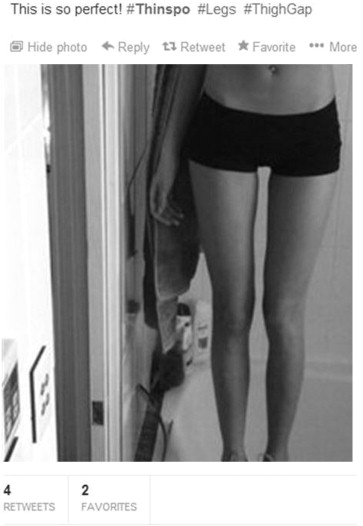Yet such 'thinspiration' images are also considered body shaming of overweight people by some. The 'Objectification' hypothesis of cultural body standards goes both ways.The Social Cognitive hypothesis also proposes that people learn from modeled behaviors and that 'thinspiration' content may be particularly important because such pictures are likely to get more positive reinforcement than unflattering pictures.
A new paper sought to analyze images of thin women and categorize them according to body depiction, sexual suggestiveness and image purpose. They note that the images were often cropped to remove heads or focus on just a few body parts that they are creating a disembodied norm.

Inspirational or demoralizing? doi:10.1016/j.bodyim.2015.03.006
U.C. Davis humanities scholars Jannath Ghaznavi and associate professor Laramie Taylor examined about 300 photographs from Twitter and Pinterest postings that used the terms “thinspiration” and/or “thinspo” to tag images and ideas promoting extreme thinness and often casting eating disorders in a positive light.
“Imagine a teenage girl or even a young woman looking for inspiration using terms such as ‘attractive,’ ‘fit,’ or ‘pretty,’” Ghaznavi said. “She will likely find images of headless, scantily clad, sexualized women and their body parts.”
Images from Twitter, popular among younger audiences, were most likely to be cropped to remove heads and focus on specific body parts compared to Pinterest, according they found.
A content analysis obviously cannot speak to the effects of viewing the images, the researchers concede, but they point to studies that have shown repeated exposure to such content can result in body dissatisfaction and disordered eating attitudes, in much the same way advertising of junk food or cigarettes can lead some people to overdo those.
“A young woman looking at these image may think that’s what she should look like,” Ghaznavi said. “That could prompt these girls and women to resort to extreme dieting, excessive exercise or other harmful behaviors in order to achieve this thin ideal.”
Citation: Jannath Ghaznavi, Laramie D. Taylor, 'Bones, body parts, and sex appeal: An analysis of #thinspiration images on popular social media', Body Image Volume 14, June 2015, Pages 54–61 doi:10.1016/j.bodyim.2015.03.006





Comments